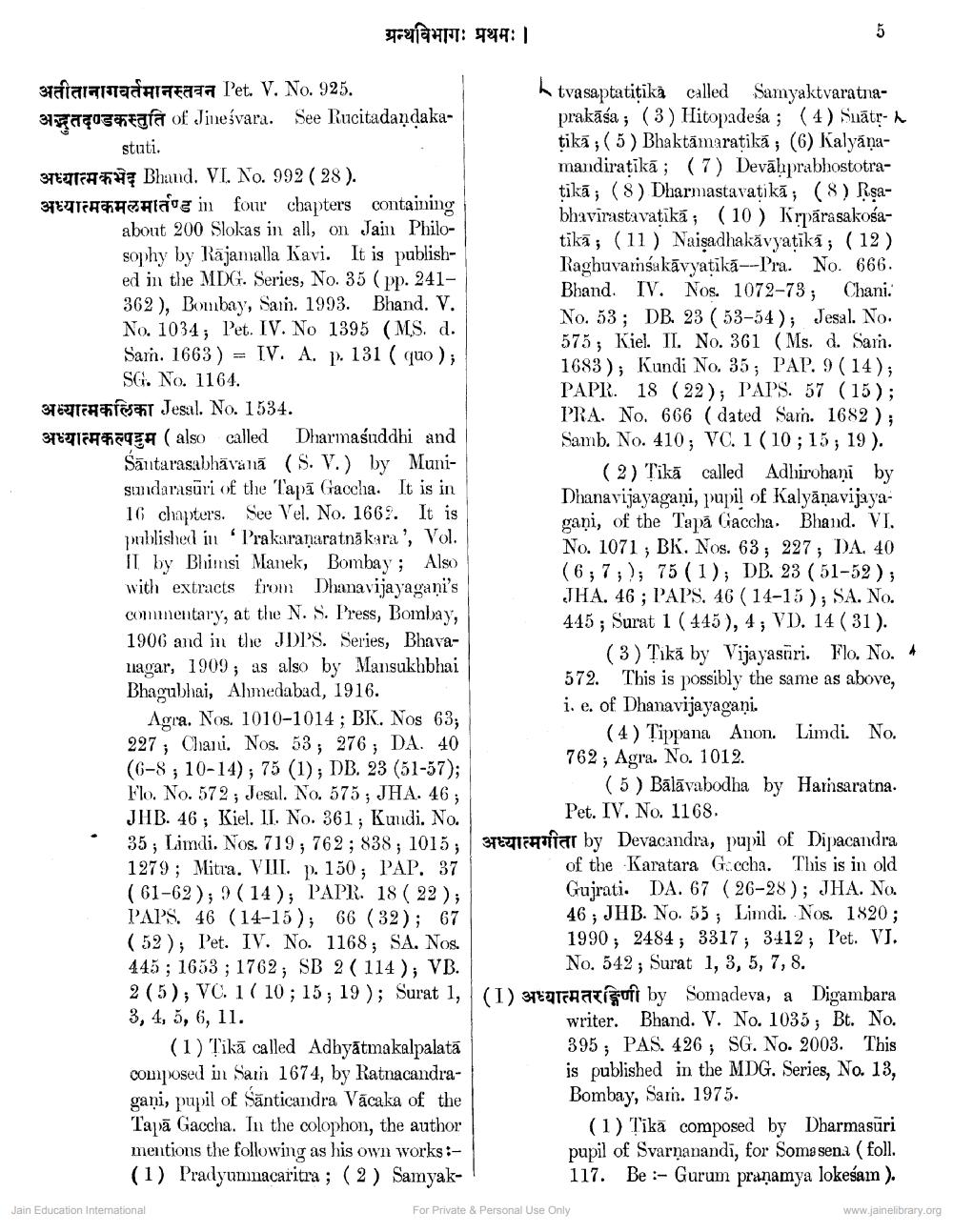________________
अतीतानागवर्तमानस्तवन Pet. V. No. 925. अद्भुतदण्डकस्तुति of Jineśvara. See Rucitadandaka
stuti.
Bhand. VI. No. 992 (28).
अध्यात्मकमलमार्तण्ड in four chapters containing about 200 Slokas in all, on Jain Philosophy by Rajamalla Kavi. It is published in the MDG. Series, No. 35 (pp. 241362), Bombay, Sain. 1993. Bhand. V. No. 1034; Pet. IV. No 1395 (MS. d. Sarn. 1663) IV. A. p. 131 ( quo); SG. No. 1164.
ग्रन्थविभागः प्रथमः ।
=
अध्यात्मकलिका Jesal. No. 1534. अध्यात्मकल्पद्रुम (also called Dharmaśuddhi and Santarasabhavana (S. V.) by Munisundarasuri of the Tapa Gaccha. It is in 16 chapters. See Vel. No. 1662. It is published in Prakaranaratnākara', Vol. II by Bhimsi Manek, Bombay; Also with extracts from Dhanavijayagani's commentary, at the N. S. Press, Bombay, 1906 and in the JDP'S. Series, Bhavanagar, 1909; as also by Mansukhbhai Bhagubhai, Ahmedabad, 1916.
Jain Education International
(1) Tika called Adhyatmakalpalata composed in Sam 1674, by Ratnacandragani, pupil of Santicandra Vacaka of the Tapa Gaccha. In the colophon, the author mentions the following as his own works:(1) Pradyumnacaritra; (2) Samyak
L
5
tvasaptatițika called Samyaktvaratnaprakāśa; (3) Hitopadeśa; (4) Suatrțikā; (5) Bhaktamaraṭikā; (6) Kalyāṇamandirațikā; (7) Devaḥprabhostotrațikā; (8) Dharmastavaṭikā; (8) Rṣabhavirastavatika; (10) Krparasakosatika; (11) Naiṣadhakavyaṭīkā; (12) Raghuvamsakāvyaṭika--Pra. No. 666. Bhand. IV. Nos. 1072-73; Chani. No. 53; DB. 23 (53-54); Jesal. No. 575; Kiel. II. No. 361 (Ms. d. Sarn. 1683); Kundi No. 35; PAP. 9 (14); PAPR. 18 (22); PAPS. 57 (15); PRA. No. 666 (dated Sam. 1682); Samb. No. 410; VC. 1 (10; 15; 19).
(2) Tikā called Adhirohani by Dhanavijayagani, pupil of Kalyanavijayagani, of the Tapa Gaccha. Bhand. VI. No. 1071; BK. Nos. 63; 227; DA. 40 (6;7;); 75 (1); DB. 23 (51-52); JHA. 46; PAPS. 46 (14-15); SA. No. 445; Surat 1 (445), 4; VD. 14 (31).
Agra. Nos. 1010-1014; BK. Nos 63; 227; Chani. Nos. 53; 276; DA. 40 (6-8; 10-14); 75 (1); DB. 23 (51-57); Flo. No. 572; Jesal. No. 575; JHA. 46; JHB. 46; Kiel. II. No. 361; Kundi. No. 35; Limdi. Nos. 719; 762; 838; 1015; 1279; Mitra. VIII. p. 150; PAP. 37 ( 61–62);? (14); PAPR. 18(22), PAPS. 46 (14-15); 66 (32); 67 (52); Pet. IV. No. 1168; SA. Nos. 445; 1653; 1762; SB 2 (114); VB. 2 (5); VC. 1(10; 15; 19); Surat 1, (1) rift by Somadeva, a Digambara 3, 4, 5, 6, 11.
writer. Bhand. V. No. 1035; Bt. No. 395; PAS. 426; SG. No. 2003. This is published in the MDG. Series, No. 13, Bombay, Sam. 1975.
(3) Tika by Vijayasuri. Flo. No. 4 This is possibly the same as above, i. e. of Dhanavijayagani.
572.
(4) Tippana Anon. Limdi. No. 762; Agra. No. 1012.
(5) Bālāvabodha by Hamsaratna. Pet. IV. No. 1168.
far by Devacandra, pupil of Dipacandra. of the Karatara Gaccha. This is in old Gujrati. DA. 67 (26-28); JHA. No. 46; JHB. No. 55; Limdi. Nos. 1820; 1990, 2484, 3317; 3412; Pet. VI. No. 542; Surat 1, 3, 5, 7, 8.
(1) Tika composed by Dharmasuri pupil of Svarnanandi, for Soms sena (foll. 117. Be Gurum pranamya lokeśam).
For Private & Personal Use Only
www.jainelibrary.org




